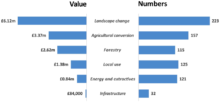By Harriet Williams, JMG Foundation, 10th January 2017
Philanthropic investment is associated with several powerful qualities that other sources of finance rarely possess. Its ability to take risks. To fill gaps. To pioneer change. To build movements.
It’s true that these things are value-laden terms – one donor’s risk is another’s comfort zone, and what one beholds as a gap in need of filling, another could see as an effort that does not justify the return.
Whatever aspirations they set for themselves, how are individual donors to judge whether or not their grants are hitting the mark?
A good knowledge of where other donors are directing their grant finance would seem important to answering this question, enabling foundations to fulfil their brief. If my grants programme is all about conserving uncharismatic species, for instance, at what point do I decide that our chosen creatures have become popular enough to be handed off to other funders? If I see a low accrual of grant spend to a country that my board deems strategic, should we look to direct more of our own grants there?
With a view to furnishing this peer-to-peer knowledge, EFN’s Forest Funders Group has developed a methodology for mapping forest-related grants. The aim is to profile the flow of forest grants around specific issues, geographies and theories of change, and in doing so help funders to gain a better sense of forest philanthropy in the round, and reflect on the place of their portfolios within it.
The mapping has been piloted on grants data submitted by five UK-based foundations, which made 652 grants between them in the study period (2011 to 2015), averaging £3.1m per year. Although this captures only a fraction of the global total – forest-related philanthropy is likely to be in the order of £60m per year – it does yield some tantalising points for reflection.
The picture that emerges shows great variability between foundations, in terms of spend, investment priorities and grantees. As in other grants mappings (including the EFN’s flagship Where The Green Grants Went series), overall spend is dominated by a small-ish number of large grants (in this case including four £1m+ awards), followed by a goodly chunk of funds in the £20,000 to £200,000 bracket, with a long tail of smaller grants (including 470 of less than £5,000). This invites reflection on what is a ‘useful’ or ‘appropriate’ grant size – the answer tempered by what it is you wish to achieve, by delivery costs and sometimes by the grantee’s capacity to receive.
Within this dataset, most grant spend (£12.4m, or 80 per cent) accrues to large organisations headquartered in the UK and US, albeit for work geared towards protecting forests in tropical countries (for instance, through the training of conservation leaders, or campaigning along the supply chains of palm oil and other forest-risk commodities). UK- and US-based groups received a lower proportion in terms of grant numbers (172 grants, 25% of the total), with the sub-£5,000 grants in particular tending to go directly to groups based in forest countries. India, Papua New Guinea, Russia and Cameroon are among the countries in which there appears to be high demand for grants among local organisations, but relatively little funding available, at least among the set of foundations analysed here.
Again, these results pose interesting questions. Is the concentration of forest philanthropy upon a relatively small set of Western-based organisations problematic? What is the scale of re-granting going on? Should funders look to make more grants directly to NGOs based in forest countries? What are the barriers to doing so?
Turning to the forest locations prioritised by grantees, we see that one-third of grant spend (£5.2m) was directed towards the South and Central America, one-fifth (£3m) to Asia and one-sixth (£2.4m) to Africa – of which less than £1m focused on the Congo Basin countries.
Grants were assigned to six issue categories: Landscape Change (including forest restoration schemes), Agricultural Conversion (where the chief focus was palm oil), Forestry (industrial and illegal logging), Local Use (sustainable farming and income generation), Energy & Extractives (mining, hydropower, oil) and Other Infrastructure (roads etc). Figure 1 shows how spend broke down between these categories.
FIGURE 1
(click on the image to see a larger version)
Figure 2 starts to tell the story of these issues at regional level. We see a cluster of Agricultural Conversion and Forestry grants in SE Asia, reflecting major international campaigns to reform Indonesia’s palm oil and pulp sectors. South America received by far the largest number of grants on Energy & Extractives, reflecting strong activism against corporate resource extraction, and controversies involving oil exploration and so-called mega-dams.
FIGURE 2
(click on the image to see a larger version)
Looking at this, how well do the grant numbers map onto the real world distribution of threats and opportunities? For instance, we know of a wave of industrial agriculture and forestry projects coming to Central Africa, how can we get on top of these? And what of non-energy infrastructure? Roads, ports and urban sprawl are major catalysts of deforestation, but barely feature in this array of grants. Conversely, are there areas of overcapacity – two many organisations doing too much of the same thing?
Grants mapping exercises such as this cannot provide definitive answers. But they can help to orient the discussion.
We will repeat the mapping on a larger group of funders this year – if your foundation can take part, please contact me here.
Harriet Williams joined Goldsmith Family Philanthropy in 2005, and now manages a number of environmental grant programmes. Before that she worked as journalist in the higher education and finance sectors. She has a MSc from Oxford University’s Environmental Change Institute, and a first degree in biology. She is a member of the EFN’s Committee.
Keywords: conservation, deforestation, effectiveness, funding overseas, grassroots, mapping

